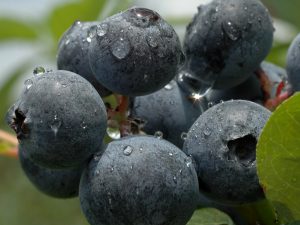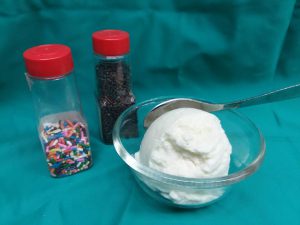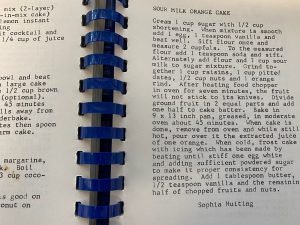
by Dorothy C. Lee | Aug 2, 2022
Blueberries were once known as star berries because of the pointy flower calyxes on top of the berries. Blueberries have grown in North America for thousands of years. Native Americans dried the berries in the sun and crushed them into a powder to be used as a rub on meats. Whole berries were added to soups, stews, and to other ingredients to make a pudding call sautauthig.

Blueberries from a Central Florida hobbiest farm. UF/IFAS Photo: Sally Lanigan.uthig.
Luscious, sweet blueberries have a nutrition profile. Blueberries are low in fat and a good source of fiber and vitamin C. Blueberries are very high in antioxidants.
Look for fresh blueberries that are firm, dry, plump, smooth skinned, and relatively free from leaves and stems. Color should be deep purple blue to blue-black; reddish berries are not ripe but may be used in cooking.
Blueberries will keep a day or two at room temperature. They will remain fresh in the refrigerator for up to 2 weeks. Cover berries to prevent dehydration. Reddish berries will be sour but will ripen if placed in a container with a few ripe berries and left uncovered at room temperature for a day or two.
Fresh berries should be stored covered in the refrigerator and washed just before using. Use berries within 10 days of picking or purchasing.
Blueberries are easily frozen for later use. Freeze unwashed blueberries in airtight, resealable plastic bags. If thawed, keep refrigerated and use within 3 days.
Next time you are shopping in the produce department, add fresh blueberries to your shopping cart and enjoy the delicious flavor of the berries.
BLUEBERRY PANCAKE STACKS
- Vegetable oil for cooking
- 1 cup milk
- 1 tablespoon vegetable oil
- 1 egg
- 1 cup all-purpose flour
- ½ teaspoons baking powder
- 1 teaspoon salt
- 1 cup fresh blueberries
- Dash of nutmeg
In a mixing bowl, stir together the milk, oil, and egg. In a separate bowl, combine the flour, sugar, baking powder, salt, and nutmeg. Add dry ingredients to the milk and stir just until mixed (batter should be slightly lumpy). Gently fold in the berries. Spoon the batter onto a griddle or pan greased with vegetable oil and heated to medium-hot (dollops should be about the size of a silver dollar). Let the batter cook until the tops of the pancakes begin to bubble, then flip and cook until done.
Stack and serve immediately with softened margarine and warm syrup.
Makes about eighteen 2 ½” pancakes.
BLUEBERRY SYRUP
Combine 1 pint of blueberries and 1 cup of maple syrup in a saucepan.
Heat to boiling, then lower the heat and simmer until most of the fruit has burst. Remove from heat and use a fork to smoosh the berries. The syrup will thicken as it cools. Store in the refrigerator for up to 2 days.

by Claire Davis | Jul 1, 2022
July is one of my favorite months of the year. Summer is in full swing, school is out, temperatures are soaring, and we celebrate Independence Day, as well as my birthday! While all those things are great, my favorite part about the month is celebrating National Ice Cream Month all month long! Who wouldn’t love a cold, sweet treat on a hot, summer day?
Did you know that one 1/2 cup serving of regular ice cream is considered a good source of calcium and phosphorous, containing 10% of the recommended daily value? While ice cream can be part of a balanced diet, its high calorie and fat content are something to consider. Ice cream is good in moderation, something I know I struggle with.

Cold, Delicious, and so many flavors! Photo source: Lyndsey B.
One of my favorite things about ice cream is the options are endless. Not only are there numerous flavors to choose from, but there are other options for how it can be made or served. “Add-ins” such as berries, chocolate sauce, sprinkles, and whipped cream can change how the base ice cream tastes. Some of the most popular flavors, such as vanilla, chocolate, cookie dough, strawberry, butter pecan, etc., do not need any add-ins though.
Types of ice cream also can be broken down into different categories:
- Regular ice cream is a frozen food product made from dairy products with at least 10% milk fat.
- Light ice cream contains at least 50% less fat or 33% fewer calories than regular ice cream.
- Low-fat ice cream contains no more than 3 grams of fat per serving.
- Nonfat ice cream contains less that 0.5 gram of fat per serving.
- Frozen custard, also known as French ice cream, contains a minimum of 10% milk fat as well as 1.4% egg yolk solids.
- Sherbets have a milk fat content only between 1-2%.
- Sorbet, also known as water ices, are similar to sherbet, but do not contain dairy.
- Frozen yogurt has a mixture of dairy ingredients such as milk or nonfat milk that has been cultured, as well as other ingredients for sweetening and flavoring.

Enjoy a scoop of ice cream in honor of National Ice Cream Month.
Photo source: UF/IFAS Northwest District
Since the kids are home from school, I am always looking for activities for them. Check out the recipe and instructions below for how to make your own ice cream in a bag at home!
Ingredients:
- 3 Zip-top bags: 2 quart-size and 1 gallon-size
- ¼ c. cream
- ¼ c. milk
- 1 Tbsp. sugar
- 3/4 tsp. vanilla extract
- 4-5 c. ice
- 1/3 c. salt (rock salt or large granules works the best)
- Toppings of your choice (sprinkles, chocolate syrup, fruits, whipped cream, etc.)
Directions:

A cool and refreshing sweet treat
Photo Source: Angela Hinkle
- Bag it! In a quart Zip-top bag, combine cream, milk, sugar and vanilla. Push out excess air and seal. (Double bag it to avoid spillage)
- Ice it! Add the ice and salt into the gallon zip-top bag. Then place the smaller, sealed bag into the ice.
- Shake it! Seal the bag and shake vigorously, 7 to 10 minutes. Do this until the ice cream has hardened. The more you shake, the quicker it hardens.
- Remove it! Remove the smaller bag from the big bag. Throw the big bag away.
- Top it! Either eat the ice cream out of the bag or spoon it into a bowl. Add your favorite toppings and enjoy!
Source:
https://fsi.colostate.edu/ice-cream/

by Samantha Kennedy | Apr 4, 2022
“Stressed is just desserts spelled backwards.” When I was younger, I took this saying to heart. If I was stressed, I reached for the sweets. That instant rush of sugar to my brain provided a feeling of happiness and contentment. But it was only temporary. Once the sugar high wore off, I went back to feeling overwhelmed with stress, which just made me reach for more sweets.
It took me much too long to realize this was an endless and unhealthy cycle. Stress eating, especially stress-eating junk food, was such an ingrained habit for me, I did not even think about it having negative consequences such as weight gain and high blood sugar, both of which can be exacerbated by stress itself.
More recently, I have taken an interest in healthier coping strategies. Stress is an inevitable and integral part of our lives. We cannot avoid it. But we can seek ways to deal with it that do not add even more stress (or calories) to our body. One of the most helpful strategies I have adopted to cope with stress is to strive to live more mindfully.

Spending time in nature has been shown to decrease feelings of stress, lower blood pressure, and increase feelings of calm. (Photo source: UF/IFAS File Photo)
Mindfulness has become a bit of a buzzword over the last few years, but do not let that trick you into thinking it is just a fad. Mindfulness and everything it entails has been around for decades (even longer!). Practices such as mindful breathing, tai chi, and meditation are all part of mindfulness, which is simply an umbrella term used to describe strategies for dealing with difficult emotions, managing stress, and staying present in everyday life.
One of the things I have found most valuable in my foray into mindfulness is the ability to better recognize the signs of stress in my body. Early recognition of stress signals allows me to put one of my new mindfulness skills into practice to combat their effects. This may include simply pausing for a few moments and consciously breathing or taking a short walk in the sunshine while allowing the sounds around me, and not my stressful thoughts, to become the focus of my attention.
Another good practice for stress reduction in general is to immerse yourself in nature whenever possible. Whether that is hiking one of the many local nature trails, kayaking in the springs, or relaxing at the beach while listening to the waves, spending time in nature has been shown to alleviate stress. Even watching a brief nature video online has been shown to lower blood pressure and elicit feelings of calm.
April is Stress Awareness Month. I challenge everyone to take some time this month to really think about what stress looks like for you and how it shows up in your mind and body. How do you usually cope with it? If the answer involves over-indulgence in a substance such as food or alcohol, I urge you to try a new, healthier way to cope. Go for a walk. Focus on your breath. Even try meditation with the help of a mindfulness mobile app. It may feel weird at first, but if you keep at it, it will soon become a new healthy habit that you will reach for instead of that bag of chips.
UF/IFAS is an Equal Opportunity Institution.

by Amy Mullins, PhD, RDN | Nov 24, 2021
The holiday season is finally upon us. It’s a time for enjoying family, friends, and food!
You can make healthy habits this holiday season. It’s not only a single meal but rather an entire season of parties, events, gatherings festivities, and unhealthy choices that add up to that holiday weight gain we resolve to lose when January rolls around. As the holiday season begins its rapid approach, take time and consider those eating habits that set your new year off on the wrong foot. Why not make a resolution now to eat healthier this holiday season?
Just a few simple strategies can help make the difference and keep those unwanted pounds away. Here are some suggestions:
- Don’t skip meals. Eating healthy on a regular basis will keep you from overindulging at holiday gatherings.
- Use smaller plates for meals and gatherings and be mindful of portions
- Choose more vegetables and smaller helpings of entrees and desserts
- Drink more water and minimize alcoholic drinks and eggnog
- Make healthier recipe ingredient substitutions when cooking and baking
Take a mindful approach to keeping your personal health goals in-check. We can all still experience the joy of the holiday season, without making food the focus. Make a resolution to be mindful and eat healthier this holiday season, and your waistline will thank you!
 Learn more about making healthy habits this holiday season!
Learn more about making healthy habits this holiday season!
— Tips for Making Healthy Choices
— Simple Substitutions
— Diabetes During the Holidays
— How to Add Fruits and Veggies
— Cranberry Nutrition
— Cranberry Sauce Recipe
— Holiday Food Safety Tips
Click here to read the newsletter.

by Amy Mullins, PhD, RDN | Nov 23, 2021
 Take care of your bones today for better quality of life tomorrow!
Take care of your bones today for better quality of life tomorrow!
According to the National Institutes of Health, about one in every two Americans over the age of 50 may already have or be at risk of developing osteoporosis. (1) Osteoporosis is a disease where, over time, bone quality and strength decline, making bones more likely to fracture and break. Fractures can develop not only as a result of a slip or fall but also from everyday sneezing or coughing. If your doctor diagnoses you with osteoporosis, the best course of action for slowing its progression may be prescription medication. However, nutrition and exercise can help provide a good foundation to prevent or delay disease development. (1)
Know Your Risks
While all risks are not completely understood, there is a genetic factor linked to osteoporosis – mainly, if poor bone mineral density runs in the family. In addition to genetic factors, poor nutrition, smoking, excessive alcohol, and a lack of exercise can all increase your risk of developing osteoporosis. It is important to talk to your doctor to discuss your level of risk and prevention measures. (1)
Build More Bone
Although they may not seem like it, bones are a living tissue and go through times of building and breakdown during the life cycle. Bones grow the most during childhood, but they also change and become stronger as an adult by doing exercises like weightlifting or running. (1) Similar to a savings account or retirement fund, the more you build when you are young, the more you can afford to spend as you age. Current recommendations to support strong bones include muscle strengthening exercises at least two times per week. These exercises require your muscles to do more work than doing just day-to-day activities. Additionally, strength training exercises should be done to the point where it would be difficult to perform one or two more repetitions. Examples include lifting weights, working with resistance bands, and doing body weight exercises such as push-ups, pull-ups, and planks. Additionally, climbing stairs, and carrying heavy loads (such as groceries and heavy gardening) also count when done frequently.(2)
Support Your Bones
In addition to exercise, nutrition plays a large role in promoting healthy bones. The two most important nutrients for bone health are calcium and vitamin D. Calcium is what gives bones their strength but is also involved in many other processes in the body. If you do not regularly consume enough calcium, your body takes it from your bones. (3) If this happens for long enough, your bones will become weakened and begin to develop osteoporosis. Vitamin D is important for the absorption of calcium. Not having enough vitamin D can impact your bones, even if you get enough calcium from your diet. (4)
| Life-stage group |
Calcium (mg/day) |
Vitamin D (IU/day) |
| Infants 0-6 months |
200 |
400 |
| Infants 6-12 months |
260 |
400 |
| 1-3 years old |
700 |
600 |
| 4-8 years old |
1,000 |
600 |
| 9-13 years old |
1,300 |
600 |
| 14-18 years old |
1,300 |
600 |
| 19-30 years old |
1,000 |
600 |
| 31-50 years old |
1,000 |
600 |
| 51–70-year-old males |
1,000 |
600 |
| 51–70-year-old females |
1,200 |
600 |
| > 70 years old |
1,200 |
600 |
| 14-18 years old, pregnant/lactating |
1,300 |
600 |
| 19-50 years old, pregnant/lactating |
1,000 |
600 |
Recommended Calcium and Vitamin D Intakes (5) Definitions: mg = milligrams; IU = International Units
Bone Strengthening Foods
There are a variety of food sources that provide calcium and vitamin D. Calcium can be found in dairy products, green vegetables, and calcium-fortified foods. Examples of calcium-containing dairy products include cheese, yogurt, and reduced-fat milk. Other calcium-fortified foods include breads, orange juice, cereals, and tofu. When it comes to vitamin D in your diet, be sure to include fatty fish such as tuna and salmon. There are smaller amounts of vitamin D found in cheese, mushrooms, and beef liver. Similar to calcium, there are many vitamin D-fortified foods available. Some examples are cereals, orange juice, milk, and milk products. Check out the two tables below for calcium and vitamin D food sources. (5)
Calcium Content of Selected Foods
| Food |
Serving size |
Milligram (mg) per serving |
% DV |
| Sardines, canned in oil |
3 oz |
324 |
32% |
| Cheddar cheese, shredded |
1 ½ oz |
306 |
31% |
| Nonfat milk |
8 oz |
302 |
30% |
| Yogurt, reduced fat, no solids |
8 oz |
300 |
30% |
| 2% milk (reduced fat) |
8 fl oz |
297 |
30% |
| Whole milk |
8 fl oz |
291 |
29% |
| Cottage cheese, 1% milk fat |
2 cups, unpacked |
276 |
28% |
| Mozzarella, part skim |
1 ½ oz |
275 |
28% |
| Tofu firm, with calcium |
½ cup |
204 |
20% |
| Orange juice, calcium fortified |
6 fl oz |
200-260 |
20-26% |
| Tofu soft, with calcium |
½ cup |
138 |
14% |
| Frozen yogurt, vanilla, soft serve |
½ cup |
103 |
10% |
| Ready-to-eat cereal, calcium fortified |
1 cup |
100-1000 |
10-100% |
| Turnip greens, boiled |
½ cup |
99 |
10% |
| Kale, raw |
1 cup |
90 |
9% |
| Vanilla ice cream |
½ cup |
85 |
8.5% |
| Soy beverage, calcium fortified |
8 fl oz |
80-500 |
8-50% |
| Flour tortilla |
1, 6” diameter |
37 |
4% |
| Sour cream, reduced fat, cultured |
2 Tbsp |
32 |
3% |
Adapted from Office of the Surgeon General (US). Bone Health and Osteoporosis: A Report of the Surgeon General. (7)
Vitamin D Content of Selected Foods
| Food |
Serving size |
Micrograms (mcg) per serving |
International Units (IU) per serving |
Percent DV |
| Cod liver oil |
1 Tbsp |
34 |
1,360 |
170 |
| Rainbow trout, cooked |
3 oz |
16.2 |
645 |
81 |
| Salmon (sockeye), cooked |
3 oz |
14.2 |
570 |
71 |
| White mushrooms, raw, exposed to UV light |
½ cup |
9.2 |
366 |
46 |
| 2% milk, vitamin D fortified |
1 cup |
2.9 |
120 |
15 |
| Soy, almond, & oat milk, vitamin D fortified |
1 cup |
2.5-3.6 |
100-144 |
13-18 |
| Ready-to-eat cereal, fortified with 10% DV vitamin D |
1 serving |
2.0 |
80 |
10 |
| Sardines (Atlantic), canned in oil, drained |
2 |
1.2 |
46 |
6 |
| Egg, scrambled |
1 large |
1.1 |
44 |
6 |
| Beef liver, braised |
3 oz |
1.0 |
42 |
5 |
| Tuna fish (light), canned in water, drained |
3 oz |
1.0 |
40 |
5 |
| Cheddar cheese |
1.5 oz |
0.4 |
17 |
2 |
| Portabella mushrooms, raw, diced |
½ cup |
0.1 |
4 |
1 |
| Chicken breast, roasted |
3 oz |
0.1 |
4 |
1 |
| Ground beef, 90% lean, broiled |
3 oz |
0 |
1.7 |
0 |
| Broccoli, raw, chopped |
½ cup |
0 |
0 |
0 |
Adapted from Vitamin D – Fact sheet for health professionals (8)
Stay Safe and Healthy as You Age
Osteoporosis can be a serious and life changing diagnosis. However, adopting healthy habits like limiting smoking and excessive alcohol consumption can decrease your risk. Consuming enough calcium and vitamin D each day and getting regular muscle building exercise at least twice a week can also help protect your bones. Women over the age of 65, or anyone diagnosed as “at risk,” should be regularly screened for osteoporosis by a doctor during their yearly physical health exam. (6,7,8)
Making healthy lifestyle choices from a young age can help prevent or delay osteoporosis, but once you’re diagnosed, the best course of action for slowing its progression may be prescription medication. Consult your doctor before beginning a new exercise program or for interactions with medications.
References
- “Osteoporosis Overview.” National Institutes of Health, U.S. Department of Health and Human Services, https://www.bones.nih.gov/health-info/bone/osteoporosis/overview.
- S. Department of Health and Human Services. Physical Activity Guidelines for Americans, 2nd edition. Washington, DC: U.S. Department of Health and Human Services; 2018.
- “Osteoporosis.” Edited by Susan Randall, Osteoporosis | Office on Women’s Health, National Institute of Arthritis and Musculoskeletal and Skin Diseases, 20 May 2019, https://www.womenshealth.gov/a-z-topics/osteoporosis.
- “Office of Dietary Supplements – Vitamin D.” NIH Office of Dietary Supplements, U.S. Department of Health and Human Services, 22 Mar. 2021, https://ods.od.nih.gov/factsheets/vitaminD-HealthProfessional/
- S. Department of Agriculture and U.S. Department of Health and Human Services. Dietary Guidelines for Americans, 2020-2025. 9th Edition. December 2020. Available at DietaryGuidelines.gov
- Palmer S. Bone Health and Diet. Today’s Dietitian. 2013;15(2):44.
- Office of the Surgeon General (US). Bone health and osteoporosis: A report of the surgeon general. Rockville (MD): Office of the Surgeon General (US); 2004. Table 7-2, Selected Food Sources of Calcium. Available from: https://www.ncbi.nlm.nih.gov/books/NBK45523/table/ch7.t2/
- Vitamin D – Fact sheet for health professionals. NIH Office of Dietary Supplements. https://ods.od.nih.gov/factsheets/VitaminD-HealthProfessional/#h3. Published August 17, 2021. Accessed November 11, 2021.
Guest contributors: Andrew Treble and Lexi Fraino are master’s students and Dietetic Interns from Florida State University’s Department of Nutrition & Integrative Physiology.

by Heidi Copeland | Nov 23, 2021
Since I can recall, I’ve liked to read cookbooks. Old cookbooks, famous cookbooks, church cookbooks, regional and seasonal cookbooks, and cookbooks hot off the press! I read the forward and the preface (… if there is one). I don’t just look at the pictures, but I read the recipe for yield (number of servings), ingredients and amounts, and the way the ingredients are combined. I read about the equipment required to prepare the recipe and the amount of time it takes to complete the task.

A narrative format is common with many older or handwritten recipes.
Photo credit: Heidi Copeland
Generally, I have found that old cookbook recipes often seem different and that handwritten, handed-down recipes tend to be vague. I also have found that the product does not always turn out like the picture. Yields – the amount a recipe feeds – has certainly changed over time and recipe ingredients have become more and more varied, as has their use. Who knew toasting spices completely changes their flavor profile and that umami is important?
It used to be that people learned to cook by watching someone else. However, that seriously changed as more and more folks became literate. In fact, the first cookbook published in the United States, American Cookery (Hartford Connecticut 1796), has been designated by The Library of Congress as one of the 88 books that shaped America. This first cookbook used uniquely American ingredients of the time and provided American cooks with quite a litany of receipts, the old-world way of documenting what we now call a recipe.
Recently, I listened to a radio interview with Adrien Miller, a cookbook author who has been on a quest to document uniquely African American cooking histories.
I chuckled to hear Adrien Miller describe a handwritten recipe from a friend or a relative as a lesserpe… his terminology for the unexacting nature of a recipe given from someone who really doesn’t need an exact rendition because they know what they are doing and assume you do, too.
Recipes are a great way to hand down our own historical traditions. However, having been charged with giving out a lesserpe…, I find it is critically important to be as exacting as possible when sharing recipes with friends or family.
A good, standard format for a recipe includes:
- Name of product
- Yield of product (how many it serves)
- Ingredients in exact amounts (in order of use is helpful)
- Step-by-step instructions, in detail
- Time and temperature specifics
- Important information about pan size, etc.
Remember, too, that a recipe is a history. History evolves. Aunt Margaret might have written a narrative format (paragraph) recipe but today that form might be seen as hard to follow.
Here is an example from Aunt Margaret:
Apple Pie (2 crust)
Preheat oven to 425 degrees. Line a 9-inch pie pan with your favorite crust. Combine and sift together 1/2 – 2/3 cup white sugar, 1 1/2 tablespoons cornstarch, 1/4 teaspoon nutmeg, 1/2 teaspoon cinnamon. Combine and sift over apples (about 3#, cut up). Stir apples gently until well coated. Place in pie shell and dot with butter. Cover pie, slit or prick crust. Bake at 425 degrees for about 15 minutes then reduce heat to 375 degrees. Bake until done.
The typically formatted recipe:
Apple Pie (Aunt Margaret)
Serves 8 to 10
2 pie crusts, purchased or homemade
3 pounds Granny Smith apples, approximately 8 large apples
1/2 cup white sugar, more if you like it sweeter
1 1/2 tablespoons cornstarch
1/4 teaspoon nutmeg
1/2 teaspoon cinnamon
2 tablespoons butter, firm, sliced thin
1 egg yolk
2 tablespoons cream
- Preheat oven to 425°F.
- Wash, peel, core, and slice the apples thinly.
- In a large bowl, toss sliced apples with sugar, cornstarch, nutmeg, and cinnamon.
- Line 9” pie pan with 1 piecrust
- Mound the apple mixture in the center of the pie crust.
- Dot the apple mixture with sliced butter.
- Cover apples with 2nd pie crust.
- Crimp edges of the pie crust. (Press the top and bottom dough rounds together as you flute edges using thumb and forefinger or press with a fork.)
- Mix egg yolk and cream, brush all over the pie crust top.
- Stick with fork tines in a dozen places or vent with small knife-made slits.
- Bake 15 minutes in the preheated 425°oven.
- Reduce the temperature to 375°. Continue baking for 35 to 45 minutes, until apples are soft and the crust is golden brown.
- Transfer the apple pie to a rack to cool for at least 1 hour.
- Serve warm or cold.
Notes:
- Place the pie on a baking sheet to catch any drips before you bake it.
- At any point during the baking, if the top of the pie begins to brown too much, just tent it with aluminum foil.
- Your dad does not like nutmeg. I add a splash of vanilla, a bit more cinnamon, and omit the nutmeg.
- Don’t forget the vanilla bean ice-cream. It adds a nice touch!
This holiday season, don’t be blamed for sharing less than the whole recipe. Recipes can be a valuable tool for passing on important family food traditions, now and into the distant future. Learn to write a good recipe with details. You might just be the talk of the table for eons.
Library of Congress: American Cookery














